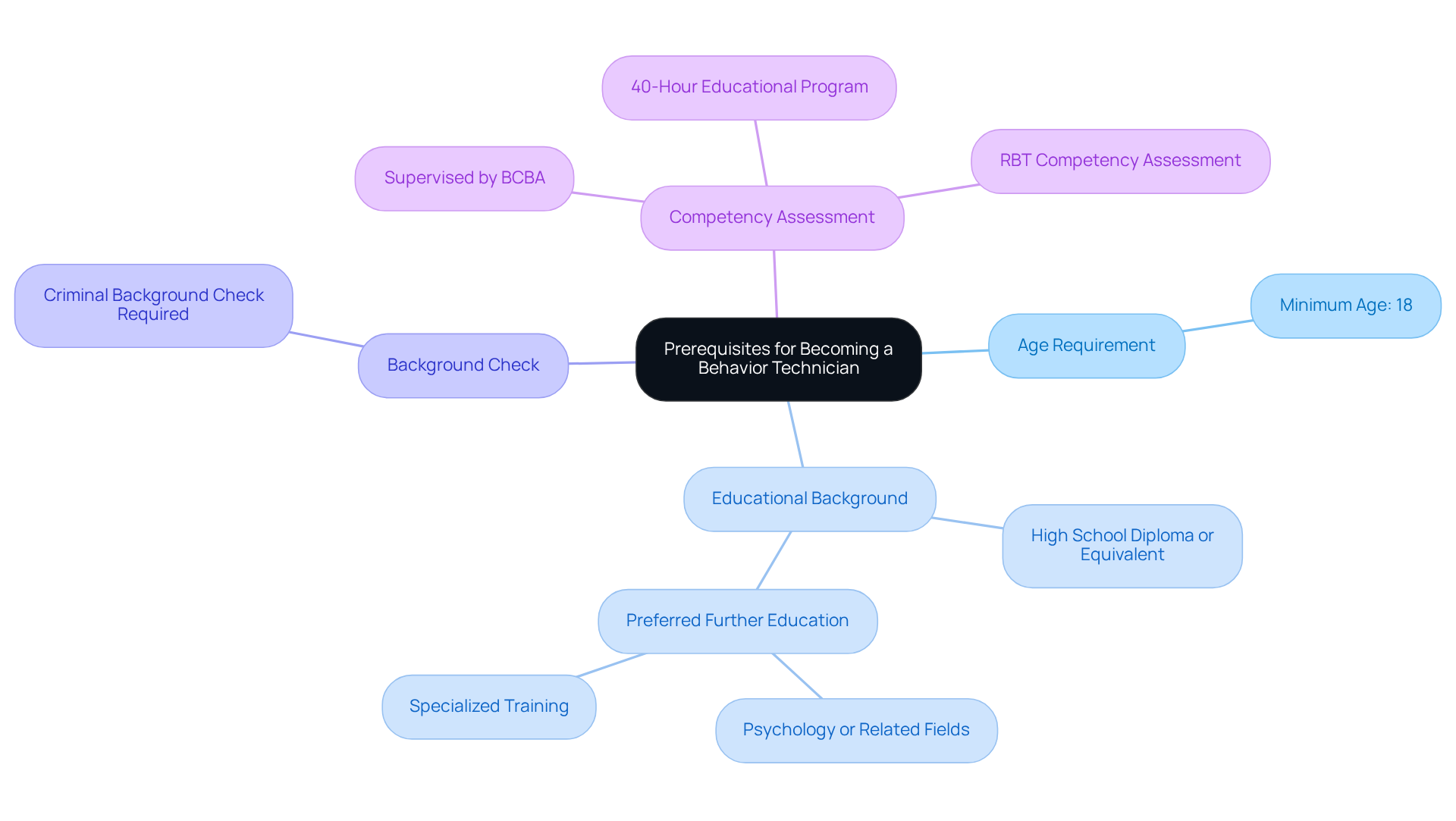Overview
To become a behavior technician, individuals must fulfill specific prerequisites. These include:
- Being at least 18 years old
- Possessing a high school diploma
- Passing a background check
- Successfully completing a 40-hour training course followed by a competency evaluation
The importance of these essential steps cannot be overstated, particularly in light of the growing demand for qualified professionals in this field. Ongoing supervision and professional development are crucial to ensuring success in this rewarding career. As the need for skilled behavior technicians increases, so does the opportunity for individuals to make a meaningful impact in their communities.
Introduction
Embarking on the journey to become a behavior technician is a rewarding yet intricate process, characterized by specific prerequisites and training requirements. As the demand for skilled professionals in Applied Behavior Analysis (ABA) continues to surge, grasping the essential steps to certification is crucial for aspiring technicians.
- What challenges might candidates encounter in this pursuit?
- How can they ensure they are adequately prepared to address the evolving needs of the profession?
Understanding these dynamics will empower you to navigate your path with confidence.
Understand the Prerequisites for Becoming a Behavior Technician
To understand , candidates must fulfill specific prerequisites that ensure they are well-prepared for the role.
By meeting these prerequisites, aspiring behavior technicians can confidently advance in their careers while understanding how to become a behavior technician, aligning with the growing demand for qualified professionals in the field. The demand for Registered Support Technicians is expected to increase by 10% by 2032, creating a favorable opportunity to join the profession. As the road to obtaining RBT certification requires dedication and commitment, those who are passionate about helping others will find this career path rewarding.

Complete the Required Training and Certification Process
To become a certified behavior technician, follow these essential steps:
- Enroll in a 40-Hour Training Course: This course must cover the RBT Task List, which includes critical topics such as ethical considerations, data collection, and behavior reduction strategies. Many accredited institutions provide this education in both online and in-person formats.
- Finish the Course: Engage actively in the course to grasp the core principles of Applied Behavior Analysis (ABA). The program usually includes at least 40 hours of material, which may extend slightly due to integrated quizzes aimed at reinforcing knowledge. Note that the RBT preparation program must be completed within a 180-day period.
- Pass the Competency Evaluation: After finishing your instruction, you must pass a competency assessment conducted by a Board Certified Analyst (BCBA). This assessment evaluates your practical skills and understanding of ABA techniques, ensuring you are well-prepared for real-world applications.
- Apply for Certification: Once you have successfully passed the competency assessment, you can apply for certification through the Behavior Analyst Certification Board (BACB). This process involves submitting your preparation documentation and passing .
- Take the RBT Exam: The exam consists of multiple-choice questions that assess your knowledge of ABA principles and practices. To enhance your chances of success, utilize study guides and practice exams. Notably, the overall first-time pass rate for RBT exam takers was 74% in 2023, with a median pass rate of 80.4%. This underscores the significance of comprehensive preparation and choosing high-quality programs, as five out of 31 RBT programs had first-time examination pass rates of 90% or higher in 2023.
To understand how to become a behavior technician, it's important to explore the necessary steps and qualifications.
- Maintain Certification: After obtaining your certification, you must adhere to ongoing requirements, including continuing education and supervision hours, as part of how to become a behavior technician. Staying updated with the latest training updates and best practices is crucial for your professional development in this rapidly growing field.
Additionally, the average wage for RBT roles is approximately $20 per hour, which is an important consideration for healthcare employers.
Engage in Ongoing Supervision and Professional Development
To ensure your success and growth as a behavior technician, engage in the following:
- Seek Supervision: Regular oversight from a Board Certified Analyst (BCBA) is crucial. This not only helps refine your skills but also ensures adherence to ethical standards in practice. Supervision sessions offer valuable feedback on your performance and guidance on complex situations, which is essential considering that most actively supervising BCBAs manage 10 or fewer Registered Technicians (RBTs). With the demand for BCBAs projected to increase by 25% over the next five years, ensuring adequate supervision will be vital for both personal and professional growth.
- Engage in Professional Growth: Attend workshops, webinars, and conferences related to Applied Behavior Analysis (ABA). Many organizations offer continuing education units (CEUs) necessary for maintaining your certification. In 2025, numerous opportunities will be available, including specialized training sessions that focus on managing aggressive behaviors and enhancing child outcomes through parental engagement. Staying engaged in professional development will position you favorably in a rapidly growing job market, especially for leadership and remote roles.
- Join Professional Organizations: Becoming a member of professional associations, such as the Association for (ABAI), offers networking opportunities, resources, and access to the latest research in the field. Membership can also facilitate connections with over 60,000 certified RBTs, fostering a community of practice. This networking is essential, as 24.2% of counties do not have a qualified supervisor or an RBT with an active credential, highlighting the value of professional connections.
- Stay Informed: Regularly read journals and publications related to ABA to stay updated on new techniques, research findings, and best practices. This knowledge enhances your effectiveness as you learn how to become a behavior technician, especially as ABA therapy is utilized in educational settings to support students with developmental disabilities in 85% of cases. Being informed about the latest trends will help you identify potential career advancements in this booming field.
- Reflect on Practice: Engage in self-reflection and seek feedback from supervisors and peers to identify areas for improvement. Continuous self-assessment is key to professional growth, particularly as the demand for BCBAs is projected to increase significantly. It is also important to note that half of all qualified supervisors were not supervising any Registered Behavior Technicians (RBTs), emphasizing the necessity of self-reflection and feedback in a context where supervision may be lacking. By actively reflecting on your practice, you can better prepare yourself for future opportunities in the expanding ABA therapy market.
Call to Action: Stay ahead in your career by submitting your resume to explore new opportunities in the growing ABA therapy field.
Conclusion
To embark on a rewarding career as a behavior technician is to step into a field of increasing demand and personal fulfillment. With a growing need for qualified professionals in behavioral health, understanding the necessary steps, such as age requirements, educational background, and the completion of a rigorous training program, is crucial. This foundational knowledge not only prepares aspiring technicians but also positions them to meet a critical need in society.
Key elements of this journey include:
- Completing a 40-hour training course
- Passing competency evaluations
- Maintaining certification through ongoing education and supervision
Are you aware of the latest trends in Applied Behavior Analysis (ABA)? Engaging in professional development, seeking mentorship, and staying informed are vital for career advancement. A proactive approach to learning and growth is indispensable in navigating the evolving landscape of behavior therapy.
Ultimately, the journey to becoming a behavior technician is marked by dedication and a commitment to excellence. By enhancing skills and connecting with professional networks, individuals can position themselves for success in this expanding field. Embracing these opportunities not only benefits personal career trajectories but also contributes to the overall enhancement of behavioral health services in communities. Will you take the initiative to make a difference in the lives of others?
Frequently Asked Questions
What are the age requirements to become a behavior technician?
Candidates must be at least 18 years old to qualify for the role of a behavior technician.
What educational background is needed to become a behavior technician?
A high school diploma or equivalent is mandatory. However, many employers prefer candidates with additional education in psychology or related fields.
Is a background check necessary for aspiring behavior technicians?
Yes, a criminal background check is required to ensure client safety and maintain a secure environment.
What is involved in the competency assessment for behavior technicians?
Candidates must demonstrate their competencies under the supervision of a Board Certified Analyst (BCBA) and complete practical evaluations to show proficiency in Applied Behavior Analysis (ABA) principles.
How many hours of education are required to become a Registered Behavior Technician (RBT)?
Applicants must complete a 40-hour educational program to obtain RBT certification.
What is the job outlook for behavior technicians?
The demand for Registered Support Technicians is expected to increase by 10% by 2032, indicating favorable opportunities in the profession.
What qualities are important for someone pursuing a career as a behavior technician?
Dedication and a passion for helping others are essential qualities for those pursuing a career as a behavior technician.

